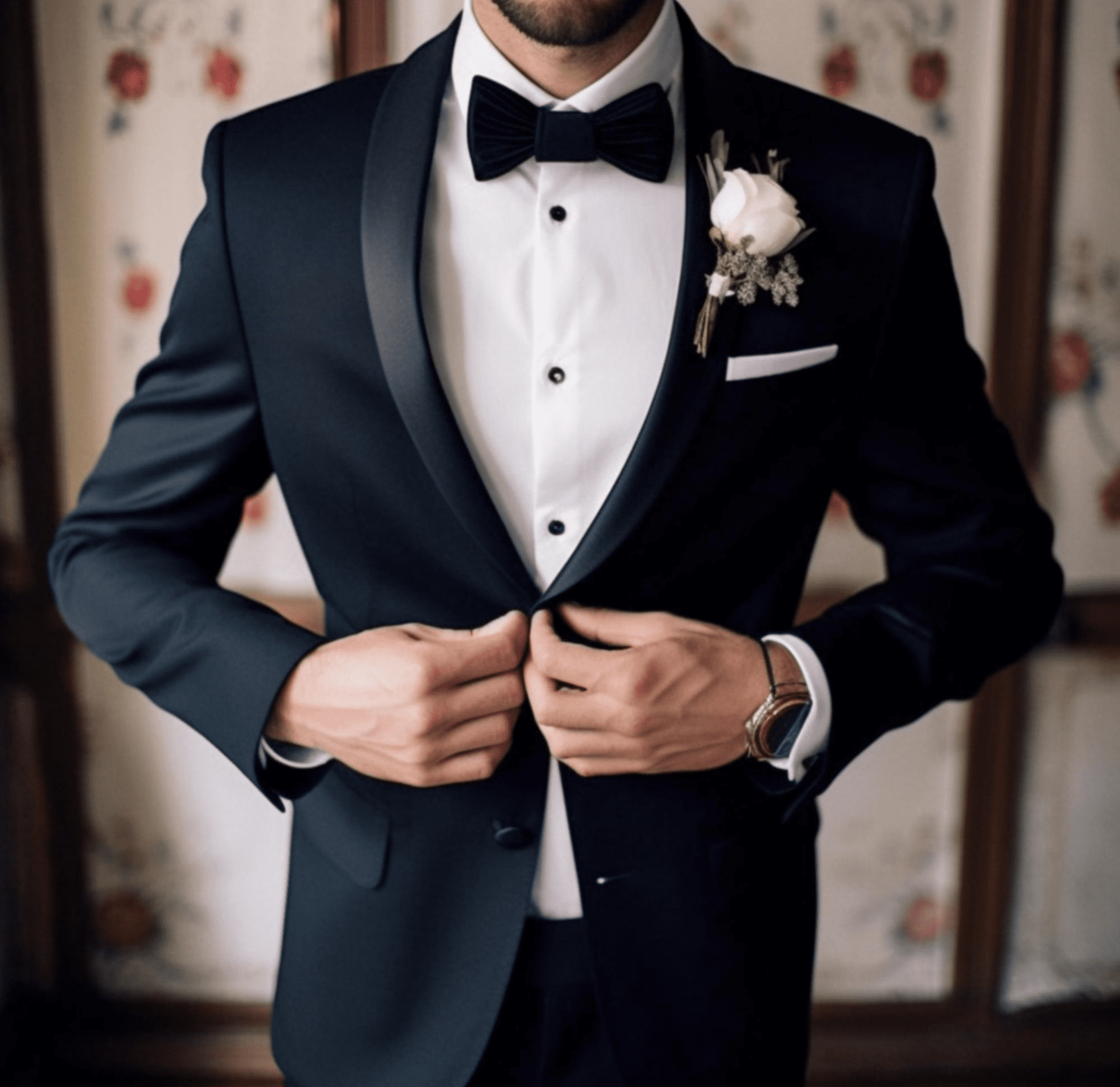
Difference Between Suit and Tuxedo: Key Distinctions for Any Event
The proper clothing is required for formal events, however there is still misunderstanding between a “suit” and a “tuxedo.” But knowing how they differ is crucial to dressing appropriately. This article breaks out the differences between tuxedos and suits, providing advice on how to choose the ideal ensemble for every occasion.
Suits vs. Tuxedos: Essentials of Formal Wear
A suit comprises coordinating jackets and trousers made from identical fabric. Suits are commonly manufactured from wool, cotton, linen, or synthetic materials and are accessible in a wide assortment of colors, patterns, and designs. Suits are esteemed as a flexible and convenient choice for both formal and semi-formal gatherings.
A tuxedo, alternatively referred to as a dinner jacket, is a formal suit typically fashioned from black or midnight blue material. Tuxedos are characterized by their glossy lapels, buttons adorned with satin, and a satin stripe running down the trousers’ leg. Traditionally, a formal white shirt, a bow tie, and shiny patent leather shoes complete the tuxedo ensemble.
key differences between a suit and a tuxedo
Let’s break down the differences between a suit and a tuxedo: how fancy they are, their style, what you wear with them, where you’d put them on, and why it’s vital they fit right.
1. Formality
The major distinction between a suit and a tuxedo lies in their formality. A tuxedo is mostly meant for very grand occasions such as weddings, posh parties, or significant award functions. On the other hand, a suit is more flexible and can be worn to various events, including work meetings and casual get-togethers.
2. Jacket Style
A key thing that sets apart a suit from a tuxedo is how their jackets look. A suit jacket often has one line of buttons with simple lapels, and it can be found in various colors and fabrics. Meanwhile, a tuxedo jacket is commonly black and has glossy lapels made of satin, giving it an extra touch of style and sophistication.
3. Bottoms
In both suits and tuxedos, the bottoms are made to look sharp and formal. But tuxedo bottoms often have shiny or fancy stripes running down the sides, matching the material on the jacket’s collar. On the other hand, suit bottoms are usually plain without any extra details.
Read More : Stylish Lehenga for Haldi Ceremony: A Touch of Yellow Charm
4. Shirt and Tie
In the case of shirts and ties, suits provide greater flexibility in selecting colors and patterns. You have a broader range of options to match your suit. Tuxedos, however, are usually matched with a pristine white shirt, a black bowtie, and sometimes a cummerbund or waistcoat for an extra touch of style.
5. Accessories
Adding the right accessories is key to completing your look whether you’re wearing a suit or a tuxedo. With a suit, you have the freedom to play around with items like pocket squares, cufflinks, and watches to express your style.
However, tuxedos demand more formal accessories such as elegant studs and cufflinks crafted from precious metals, and shiny patent leather shoes to achieve a refined appearance.
6. Occasions
Knowing the right time to sport a suit or a tuxedo is important. Suits are fitting for many celebrations like work meetings, job interviews, casual parties, or semi-fancy events. However, tuxedos are reserved for highly formal celebrations where black-tie dressing is expected, such as weddings, fancy parties, attending the opera, or other grand events.
Read More : Bridesmaid Lehenga for Wedding: Celeb-Inspired Styles to Steal the Spotlight
7. Tailoring and Fitting
No matter whether you pick a suit or a tuxedo, the size matters a lot. A suit or tux that fits properly can make you look sharper and feel more confident. It’s a wise move to go to a skilled tailor who can modify the outfit to fit your measurements, ensuring you look well-dressed and polished.
Difference Between Suit and Tuxedo: A Comparison
| Feature | Suit | Tuxedo |
|---|---|---|
| Occasion | Less formal events, business, daily wear. | Formal events, weddings, galas. |
| Satin Presence | No satin. Fabric is consistent throughout. | Satin lapels, buttons, and sometimes a stripe down the trouser leg. |
| Jacket Lapels | Notch, peak, or shawl, usually in the same fabric as the suit. | Primarily peak or shawl lapels in satin. |
| Shirt | Regular dress shirts in various patterns and colors. | Typically a white dress shirt, often with pleats or a bib front. |
| Accessories | Ties, bow ties, long ties, or no tie; minimal accessories. | Bow ties, cummerbunds, waistcoats, often with cufflinks and pocket squares. |
| Shoes | Can vary widely, often less formal. | Patent leather or highly polished dress shoes. |
| Overall Style | Versatile, ranging from casual to semi-formal. | Reserved for the most formal of occasions. |
| Button Rule | May have one, two, or three buttons. | Typically one button. |
Are there different types of suits and tuxedos?
Suits and tuxedos vary in their level of fanciness and unique details. Suits are adaptable, with different materials, colors, and styles suitable for many occasions. Tuxedos are more upscale, with shiny lapels, buttons, and pants, usually for formal events and special nights.






Leave a Reply